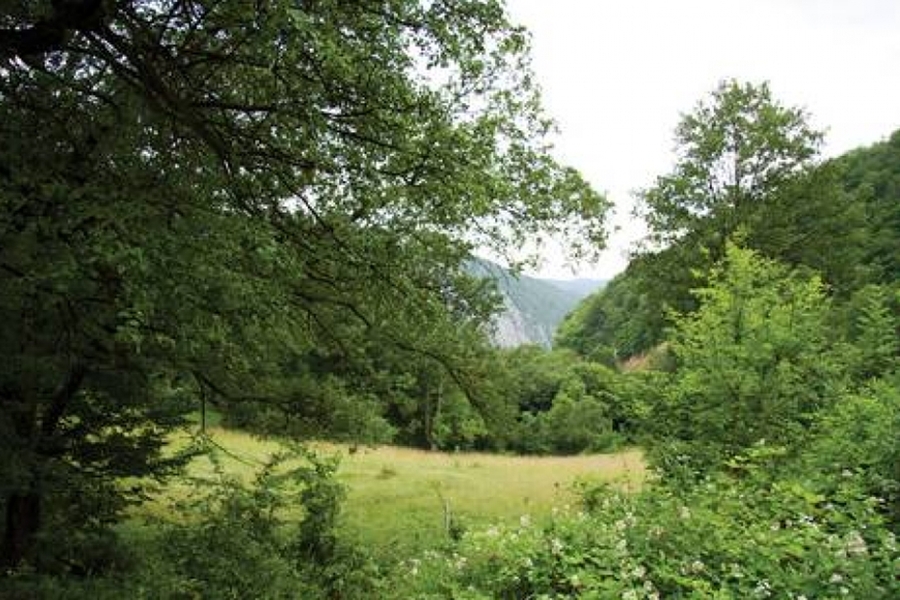The Reserve is placed in the European biogeographical region, according to European standards. Category and type of protected area: nature reserve, Category IV IUCN.
Accessibility: Orşova- Moldova Noua – DN57 up to Moldova Noua, then on the county road that connects Moldova Noua to Padina Matei. Immediately after exitin Moldova Noua, on the right side of the road to Padina Matei, there is the reserve.
Types of habitats: forest habitats and rocky teritories. Reserve area: 1179.00 hectares.
Reserve limits: The reserve is located on the territory of the town Moldova Noua, being declared by Decision 556/1973 of Caras-Severin County Council, confirmed by Decision 499/1982 and reconfirmed by Law 5/2000 – on the approval of the National Landscaping – Section III – protected areas.
Features:
Biotope – the territory is located in the Western Carpathian Mountains, subarea Banat Mountains, geomorphological unit Locvei, belonging to the group of limestone mountains and plateaus. However, the immediately adjacent mountainous area is characterized by very low altitudes and granitic rocks.
From a geological point of view, it belongs to the Danubian territory. It has a geomorphological importance, due to complex forms developed on limestone (ditches, sinkholes, uvala, , gorges, caves, potholes), found on the Big Valley or its affluents (Mudava Seacă Ogasul Rau, Ogasul Tisa, Ogasul Greci, White Waters Valley ).
In the Great Valley Basin there are 45 known caves and, among them being Gaura Haiducească (1370 m long) and Avenul Roşu (149 m level difference). Soil – the reserve is characterized by rendzinas soil and brown forest soils.
Hydrological aspects: the Reserve is located on the river Valea Mare (Great Valley), which has numerous affluents with temporary water courses. The Valea Mare watercourse is permanent.
Climate: The climate is temperate continental with mild Mediterranean influence, characterized by a moderate temperature regime, with heavy rainfall in spring, summer and winter. The average annual temperature is between 6º and 8º C. warmest period is during the months from July to August with temperatures of 16º – 18º C, while the coldest is January with average temperature of -4º -3º C.
Biocenosis:
Vegetation – the reserve is located in the European biogeographical region, characterized by the presence of numerous endemic species or of Pannonian, Balkan and sub-Mediterranean origins. The habitats of Community interest which have been reported on the territory of this reserve are 91VO Dacian Beech Forest (Symphyto-Fagion) 6210, dry meadows and facies covering bushes on limestone (* important sites for orchids) 6240 *, subpannonian grasslands .
Flora: The importance of the reserve flora is given by the high number of Daphnia laureola (large ivy), tertiary relic. The beech forest, descending from the valleys to very low altitudes of 150-200 m, occupies an area of about 400 ha. Along with beech (Fagus sylvatica), we find hornbeam (Carpinus betulus), silver linden (Tilia tomentosa), small-leaved linden (Tilia cordata), cherries (Cerasus avium), maple (Acer pseudoplatanus), horn (Cornus mas), hawthorn (Craetegus monogyna) and sometimes cărpiniţa (Carpinus orientalis), ivy (Hedera helix), cornişor(Ruscus hypoglossum), the thorn (Ruscus aculeatus), broom (Genista ovata), Winery (Asperula taurine), tendril (Clematis vitalba) etc.
Steep limestone vegetation is very diverse, with specific formations of thermophilic shrubs. Hedges are made up mostly of lilac (Syringa vulgaris), sumac (Cotinus coggygria), flowering ash (Fraxinus ornus), Turkish cherry (padus mahaleb) etc. Limestone walls and arms are covered with bushes of Sesleria filifolia or pinks (Dianthus kitaibelii, Dianthus banaticus) with the Carpathian endemisms Erysium saxosum, Draba lasiocarpa, accompanied by Centaurea atropurpurea, etc.
Suitable life conditions have found here a series of Mediterranean and Balkan species of plants, such as: Acanthus longifolius, Allium petraeum, Bupleurum praealtum, Calamintha officinalis, Echinops banaticus.
Fauna: is well represented in each class. The existence of different types of habitats, from the forest to the rocky, even temporary and permanent watercourses, induce a good representation of animals in each group.
Allowed activities: according to the Management Plan, under the provisions of GEO 57/2007, according to internal zoning of the park, the area is under full protection, which includes the most valuable assets of the natural heritage of natural protected areas.
The allowed activities are as follows:
– Scientific and educational; – Ecotourism activities, that do not require construction or investment; – Rational use of pastures for mowing and / or grazing only with domestic animals owned by community members who have pastures or holding the right to use them in any way recognized by law; – Various actions and interventions for removal / prevention / control of certain factors hazardous to natural habitats and species of flora and fauna present.
Prohibited activities: – any form of exploitation or use of natural resources and all forms of land use incompatible with the purpose of protection and / or conservation; – Construction-investment activities, excepting those for protected area management and / or scientific research or those initiated to ensure national security or the prevention of natural disasters.
The Great Valley Basin contains about 45 caves and potholes, most important being Gaura Haiduceasc[ (1370 m long) and Avenul Roşu (149 m height difference).
The Great Valley Nature Reserve is one of the most important sights in Banat, an objective which you should not miss it if you are near.






